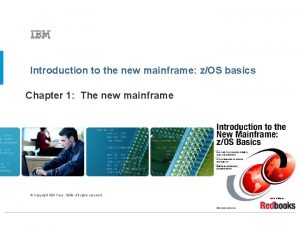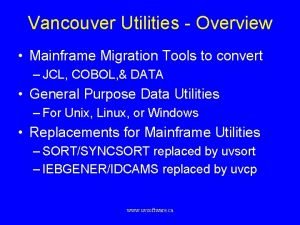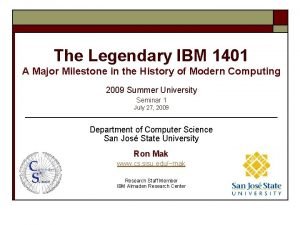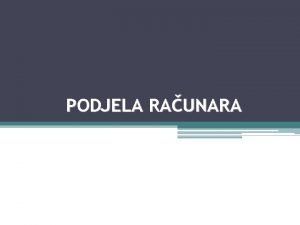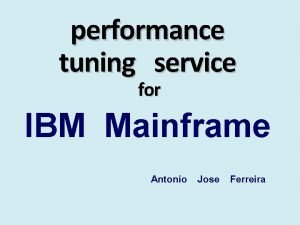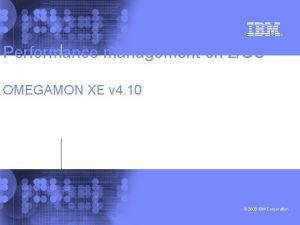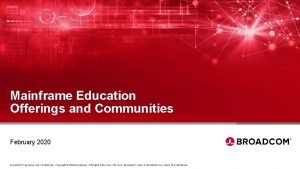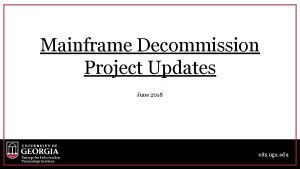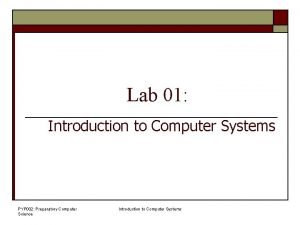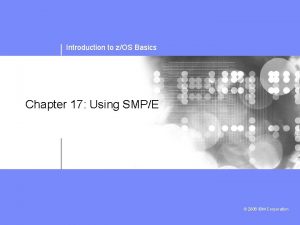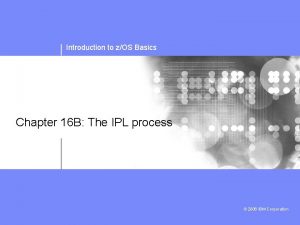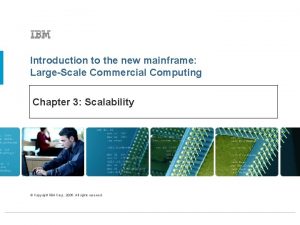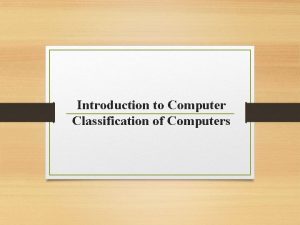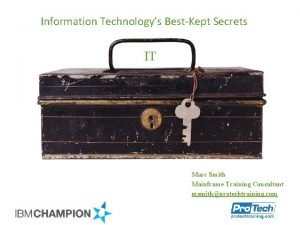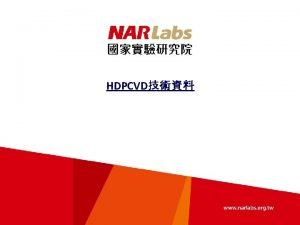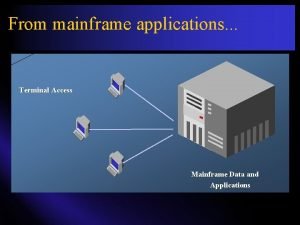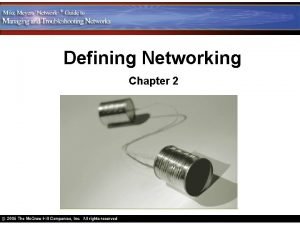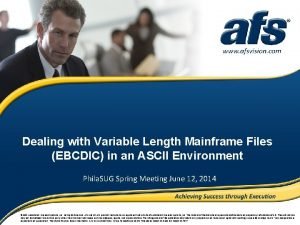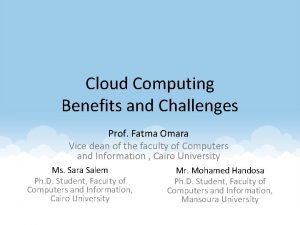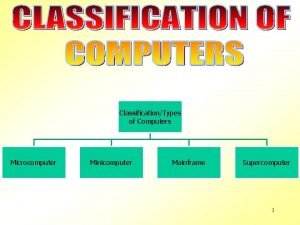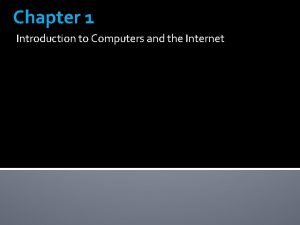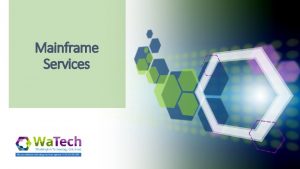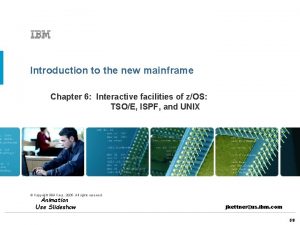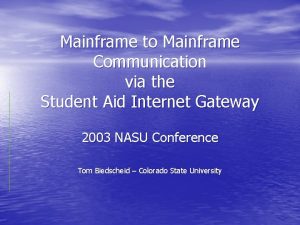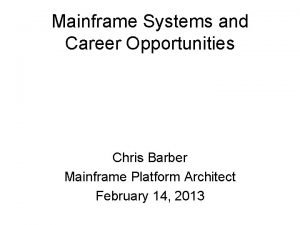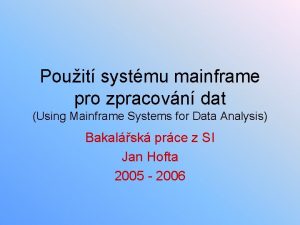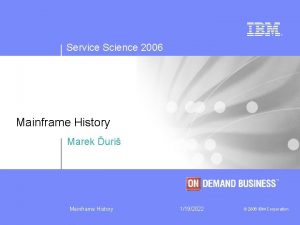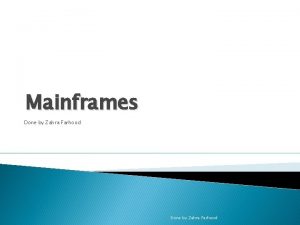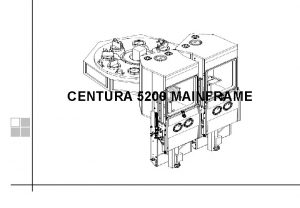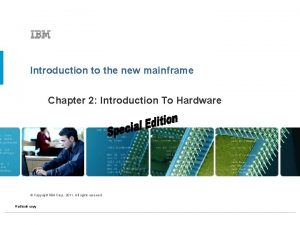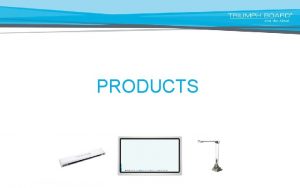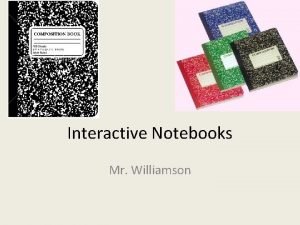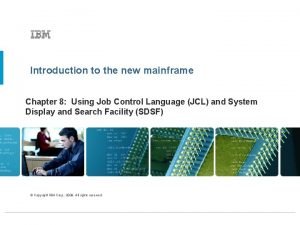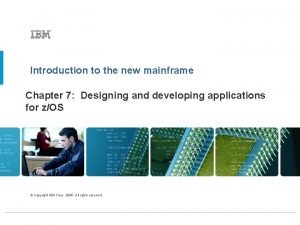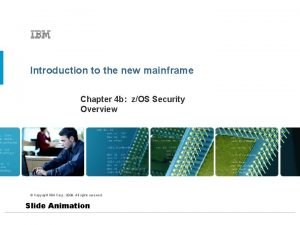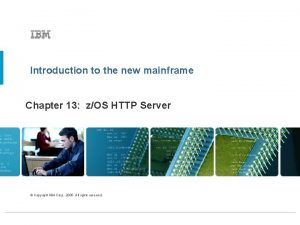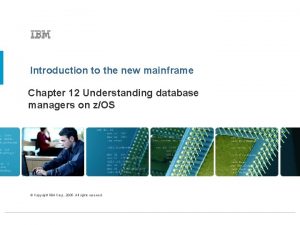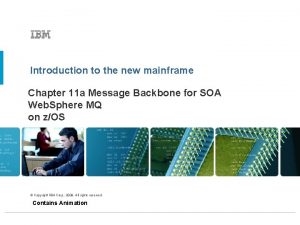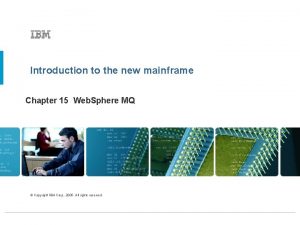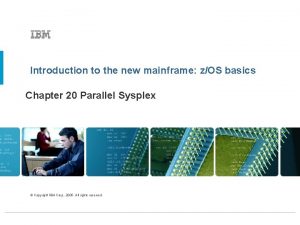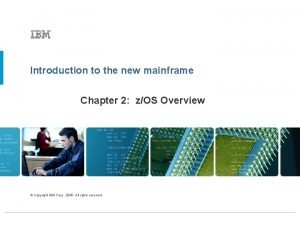Introduction to the new mainframe Chapter 3 Interactive



























- Slides: 27

Introduction to the new mainframe Chapter 3: Interactive facilities of z/OS: TSO/E, ISPF, and UNIX © Copyright IBM Corp. , 2005. All rights reserved.

Introduction to the new mainframe Chapter 3 objectives Be able to: • Log on to z/OS • Run programs from the TSO READY prompt • Navigate through the menu options of ISPF • Use the ISPF editor to make changes to a file • Use the UNIX interfaces on z/OS, including the z/OS UNIX command shell. © Copyright IBM Corp. , 2005. All rights reserved.

Introduction to the new mainframe Key terms in this chapter • 3270 and 3270 emulator • CLIST • ISHELL • ISPF • logon • native mode • OMVS command • path • READY prompt • Restructured Extended Executor (REXX) • shell • Time Sharing Option / Extensions (TSO/E) © Copyright IBM Corp. , 2005. All rights reserved.

Introduction to the new mainframe How do we interact with z/OS? TSO/E Allows users to logon to z/OS and use a limited set of basic commands. This is sometimes called using TSO in its native mode. ISPF Provides a menu system for accessing many of the most commonly used z/OS functions. z/OS UNIX shell and utilities Allows users to write and invoke shell scripts and utilities, and use the shell programming language. © Copyright IBM Corp. , 2005. All rights reserved.

Introduction to the new mainframe TSO overview TSO/E • Acronym for Time Sharing Option/Extensions (TSO/E) • Allows users to create an interactive session with z/OS • Provides a single-user logon capability and a basic command prompt interface to z/OS • Most users work with TSO through its menu-driven interface, Interactive System Productivity Facility (ISPF) © Copyright IBM Corp. , 2005. All rights reserved.

Introduction to the new mainframe TSO overview (continued) In a z/OS system, each user gets a user ID and a password authorized for TSO logon. During TSO logon, the system displays the TSO logon screen on the user’s 3270 display device or TN 3270 emulator. z/OS system programmers modify the layout and text of the TSO logon panel to better suit the needs of the system’s users. © Copyright IBM Corp. , 2005. All rights reserved.

Introduction to the new mainframe TSO/E logon screen ---------------- TSO/E LOGON -----------------Enter LOGON parameters below: Userid RACF LOGON parameters: ===> ZPROF Password ===> Procedure ===> IKJACCNT New Password ===> Group Ident ===> Acct Nmbr ===> ACCNT# Size ===> 860000 Perform ===> Command ===> Enter an 'S' before each option desired below: -Nomail -Nonotice -Reconnect -OIDcard PF 1/PF 13 ==> Help PF 3/PF 15 ==> Logoff PA 1 ==> Attention PA 2 ==> Reshow You may request specific help information by entering a '? ' in any entry field © Copyright IBM Corp. , 2005. All rights reserved.

Introduction to the new mainframe Using TSO commands in native mode • Usually, ISPF provides the interface for TSO. • However, TSO includes a limited set of basic commands independent of ISPF and other programs. • Using TSO in this way is called using TSO in its native mode. When you logon to TSO, the z/OS system responds by displaying the READY prompt, and waits for input (similar to a DOS prompt). © Copyright IBM Corp. , 2005. All rights reserved.

Introduction to the new mainframe TSO Ready Prompt © Copyright IBM Corp. , 2005. All rights reserved.

Introduction to the new mainframe Using CLISTs under native TSO Place a command list or CLIST (“see list”) in a file and execute the list as if it were a single command. A CLIST issues the commands in sequence. CLISTs are used for performing routine tasks and working more efficiently with TSO users create CLISTs with the CLIST command language. © Copyright IBM Corp. , 2005. All rights reserved.

Introduction to the new mainframe CLISTs versus REXX • REXX is Restructured Extended Executor language, a command language used with TSO • Both CLISTs and REXX offer shell script-type processing. • Both are interpretive languages, not compiled languages (although REXX can be compiled as well). • Some z/OS users write functions directly as CLISTs or REXX programs • CLIST programming is unique to z/OS, while the REXX language is used on many platforms. © Copyright IBM Corp. , 2005. All rights reserved.

Introduction to the new mainframe ISPF overview Acronym for Interactive System Productivity Facility ISPF is a menu-driven interface for user interaction with z/OS system. The ISPF environment is executed from native TSO. ISPF provides utilities, an editor and ISPF applications to the user. To the extent permitted by various security controls an ISPF user has full access to most z/OS system functions. © Copyright IBM Corp. , 2005. All rights reserved.

Introduction to the new mainframe Using ISPF allocate screen Menu Ref. List Utilities Help Allocate New Data Set Command ===> Data Set Name . . . : ZSCHOL. TEST. CNTL Management class Storage class. Volume serial. Device type. . Data class. . . Space units. . . . Average record unit Primary quantity. Secondary quantity Directory blocks. Record format. . . Record length. . . Block size. . Data set name type F 1=Help F 10=Actions . . . EBBER 1. . . TRACK (Blank for default management class) (Blank for default storage class) (Blank for system default volume) ** (Generic unit or device address) ** (Blank for default data class) (BLKS, TRKS, CYLS, KB, MB, BYTES or RECORDS) (M, K, or U) (In above units) (Zero for sequential data set) * . 2 1. 0. FB. 80. 27920 : F 2=Split F 12=Cancel (LIBRARY, HFS, PDS, or blank) (YY/MM/DD, YYYY/MM/DD F 3=Exit F 7=Backward F 8=Forward * F 9=Swap © Copyright IBM Corp. , 2005. All rights reserved.

Introduction to the new mainframe Navigating through ISPF menus To access ISPF under TSO, the user enters a command from the READY prompt to display the ISPF Primary Option Menu. You can access online help from any of the ISPF panels (press the PF 1 key) ISPF includes a text editor and browser, and functions for locating files and performing other utility functions. © Copyright IBM Corp. , 2005. All rights reserved.

Introduction to the new mainframe ISPF Menu Structure © Copyright IBM Corp. , 2005. All rights reserved.

Introduction to the new mainframe General structure of ISPF panels © Copyright IBM Corp. , 2005. All rights reserved.

Introduction to the new mainframe Common functions provided in ISPF menus… © Copyright IBM Corp. , 2005. All rights reserved.

Introduction to the new mainframe Keyboard mapping: Function Enter Exit, end, or return Help PA 1 or Attention PA 2 Cursor movement Clear Page up Page down Scroll left Scroll right Reset locked keyboard Key Ctrl (right side) PF 3 PF 1 Alt-Ins or Esc Alt-Home Tab or Enter Pause PF 7 PF 8 PF 10 PF 11 Ctrl (left side) © Copyright IBM Corp. , 2005. All rights reserved.

Introduction to the new mainframe ISPF Edit Panel - some line commands © Copyright IBM Corp. , 2005. All rights reserved.

Introduction to the new mainframe ISPF Edit Panel - Inserting lines © Copyright IBM Corp. , 2005. All rights reserved.

Introduction to the new mainframe z/OS UNIX interactive interfaces Like TSO and ISPF, the z/OS UNIX shell and utilities provide an interactive interface to z/OS. Use the UNIX shell to: • Invoke shell scripts and utilities • Write shell scripts (a list of shell commands created with the shell programming language) • Run shell scripts and C language programs interactively. © Copyright IBM Corp. , 2005. All rights reserved.

Introduction to the new mainframe Invoking the UNIX shell You can invoke the UNIX shell in any of these ways: • From a 3270 display or a workstation running a 3270 emulator • From a TCP/IP-attached terminal, using the rlogin and telnet commands • From TSO by entering the OMVS command or the ISHELL command. © Copyright IBM Corp. , 2005. All rights reserved.

Introduction to the new mainframe TSO commands used with z/OS UNIX ISHELL -- This command invokes the ISPF shell. • Intended for users more familiar with TSO/ISPF than UNIX • Provides panels for working with UNIX files, mounting and unmounting file systems, and z/OS UNIX administration. • z/OS programmers can do much of their work under ISHELL. OMVS -- This command invokes the z/OS UNIX shell. • Intended for users more familiar with UNIX than TSO/ISPF • Allows the user to alternate between the shell and TSO • UNIX programmers should find the z/OS UNIX shell programming environment familiar. © Copyright IBM Corp. , 2005. All rights reserved.

Introduction to the new mainframe ISHELL command (ish) A good starting point for TSO/ISPF users who want to use z/OS UNIX. Under ISHELL, you can use action codes to: • • • b e d r a c Browse a file or directory Edit a file or directory Delete a file or directory Rename a file or directory Show the attributes of a file or directory Copy a file or directory © Copyright IBM Corp. , 2005. All rights reserved.

Introduction to the new mainframe OMVS command shell session You use the OMVS command to invoke the z/OS UNIX shell. Under the UNIX shell, users can: • Invoke shell commands or utilities that request services from the system. • Write shell scripts using the shell programming language. • Run shell scripts and C-language programs interactively (in the foreground), in the background, or in batch. © Copyright IBM Corp. , 2005. All rights reserved.

Introduction to the new mainframe Direct login to the shell rlogin • When the inetd daemon is active, you can rlogin to the shell from a workstation. To log in, use the rlogin (remote log in) command syntax supported at your site. telnet • Also uses the inetd daemon • inetd must be active and set up to recognize and receive the incoming telnet requests. © Copyright IBM Corp. , 2005. All rights reserved.

Introduction to the new mainframe Summary TSO allows users to logon to z/OS and use a limited set of basic commands in native mode. ISPF is a menu-driven interface for user interaction with z/OS. ISPF provides utilities, an editor and ISPF applications to the user. To the extent permitted by various security controls an ISPF user has full access to most z/OS system functions. TSO ISPF should be viewed as a system management interface and a development interface for traditional z/OS programming. The z/OS UNIX shell and utilities provide a command interface to the z/OS UNIX environment. You can access the shell either by logging on to TSO/E or by using the remote login facilities of TCP/IP (rlogin). If you use TSO/E, a command called OMVS creates a shell for you. You can work in the shell environment until exiting or temporarily switching back to the TSO/E environment. © Copyright IBM Corp. , 2005. All rights reserved.
 Mainframe charter
Mainframe charter Chapter 16 toward a new heaven and a new earth
Chapter 16 toward a new heaven and a new earth Mainframe tools and utilities
Mainframe tools and utilities Ibm 1401 computer was
Ibm 1401 computer was Mainframe racunari
Mainframe racunari Mainframe performance optimization
Mainframe performance optimization Omegamon mainframe
Omegamon mainframe Mainframe disaster recovery
Mainframe disaster recovery Learning@broadcom
Learning@broadcom Onesource uga
Onesource uga Mainframe computer uses
Mainframe computer uses Smpe mainframe
Smpe mainframe Mainframe ipl process
Mainframe ipl process Mainframe scalability
Mainframe scalability Classification of computer images
Classification of computer images Smith mainframe
Smith mainframe Amat centura ii
Amat centura ii Accessing mainframe data from java
Accessing mainframe data from java Centura 5200 mainframe
Centura 5200 mainframe Used centura 5200 mainframe
Used centura 5200 mainframe Used centura 5200 mainframe
Used centura 5200 mainframe Centura 5200 mainframe
Centura 5200 mainframe Centura 5200 mainframe
Centura 5200 mainframe Mainframe ui
Mainframe ui Afs mainframe
Afs mainframe The land fatma omara
The land fatma omara Mainframe supercomputer
Mainframe supercomputer Benefits of computer oriented society
Benefits of computer oriented society
